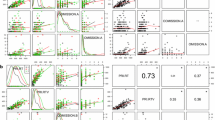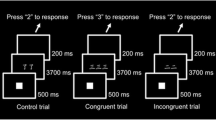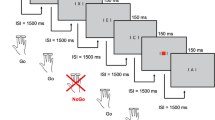Abstract
Although it has frequently been reported that hyperactive children have abnormally small P3 amplitudes of the event-related potential (ERP), which are normalized by the stimulant drug methylphenidate (MPH), the literature is inconsistent concerning earlier ERP waves. The aim of the present study was to investigate whether the normalizing effect of a 10-mg dose of MPH was also apparent on earlier waves, such as the N1, the P2, and the N2, besides the P3. Twelve attention deficit with hyperactivity disorder (ADHD) children performed a Continuous Performance Test involving a button-press response to the letter X (CPT-X) under the influence of MPH in a double-blind placebo controlled acute dosage design. ERPs were recorded at Oz, Pz, Cz, and Fz. The expected increase of the parietal P3, both to targets and nontargets, was apparent, as well as a significant increase in percentage of hits. There also was a significant increase of an earlier, negative going, wave, the N2, with a frontal maximum, under the influence of MPH. This wave was probably a manifestation of an increase in processing negativity for target stimuli only, after the intake of the stimulant drug. No effect of MPH was found on the N1 or the P2.
Similar content being viewed by others
References
Achenbach, T. M., & Edelbrock, C. S. (1983).Manual for the Child Behavior Checklist and Revised Child Behavior Profile. Queen City: Queen City Printer Inc.
American Psychiatric Association (1987).Diagnostic and statistical manual of mental disorders (3rd ed., rev.). Washington DC: Author.
Connors, C. K. (1985). Teacher questionnaire.Psychopharmacology Bulletin, 21, 823–828.
Coons, H. W., Klorman, R., & Borgstedt, A. D. (1987). Effects of methylphenidate on adolescents with a childhood history of attention deficit disorder: II. Information processing.Journal of the American Academy of Child and Adolescent Psychiatry, 26, 368–374.
Coons, H. W., Peloquin, L. J., Klorman, R., Ryan, R. M., Bauer, L. O., Perlmutter, R. A., & Salzman, L. F. (1981). Effects of methylphenidate on young adults event-related potentials.Electroencephalography and Clinical Neurophysiology, 51, 373–387.
Courchesne, E., Hillyard, S. A., & Galambos, R. (1975). Stimulus novelty, task relevance and the visual evoked potential in man.Electroencephalography and Clinical Neurophysiology, 39, 131–143.
Duncan, C. C., & Kaye, W. H. (1986). Effects of an alpha-2 adrenergic agonist on information processing: An electrophysiological analysis. In J. W. Rohrbaugh, R. Johnson, & R. Parasuraman (Eds.),8th international conference on event-related potentials of the brain (EPIC VIII). Stanford, CA: Research Reports.
Duncan-Johnson, C. C., & Donchin, E. (1977). On quantifying surprise: The variation of event-related potentials with subjective probability.Psychophysiology, 14, 456–467.
Dykman, R. A., Holcomb, P. J., Ackerman, P. T., & McCray, D. S. (1983). Auditory ERP augmentation-reduction and methylphenidate dosage needs in attention and reading disordered children.Psychiatry Research, 9, 225–269.
Edwards, A. L. (1967).Statistical methods. New York: Holt, Rinehart and Winston.
Finn, J. D. (1978).Multivariance, version VI, release 2, Fortran IV program. Chicago: National Educational Resources.
Garfinkel, B. D., Brown, W. A., Klee, S. H., Braden, W., Beauchesne, H., & Shapiro, S. K. (1986). Neuroendocrine and cognitive responses to amphetamine in adolescents with a history of attention deficit disorder.Journal of the American Academy of Child Psychiatry, 25, 503–508.
Hall, R. A., Griffin, R. B., Meyer, D. L., Hopkins, K. H., & Rappaport, M. (1976). Evoked potential, stimulus intensity and drug treatment in hyperkinesis.Psychophysiology, 13, 405–415.
Halliday, R., Rosenthal, J. H., Naylor, H., & Callaway, E. (1976). Averaged evoked potential predictors of clinical improvement in hyperactive children treated with methylphenidate: An initial study and a replication.Psychophysiology, 13, 429–440.
Halliday, R., Rosenthal, J. H., Naylor, H., & Callaway, E. (1983). Averaged evoked potential predictors of clinical improvement in hyperactive children: Dose/response effects.Electroencephalography and Clinical Neurophysiology, 55, 258–267.
Harter, M. R., & Guido, W. (1980). Attention to pattern orientation: Negative cortical potentials, reaction time, and the selection process.Electroencephalography and Clinical Neurophysiology, 49, 461–475.
Hillyard, S. A., & Hansen, J. C. (1986). Attention: Electrophysiological approaches. In M. G. H. Coles, E. Donchin, & J. W. Porges (Eds.),Psychophysiology: Systems, processes, and applications (pp. 227–243). New York: Guilford Press.
Kenemans, J. L., Verbaten, M. N., Melis, C. M., & Slangen, J. L. (1992). Visual stimulus change and the OR: Event-related potential for a two-stage process.Biological Psychology, 33, 97–114.
Kenemans, J. L., Verbaten, M. N., Roelofs, J. W., & Slangen, J. L. (1989). Initial and change ORs: An analysis based on visual single-trial event-related potentials.Biological Psychology, 28, 199–226.
Klorman, R., Brumaghin, J. T., Salzman, L. F., Strauss, J., Borgstedt, A. D., McBride, M. C., & Loeb, S. (1990). Effects of methylphenidate on processing negativities in patients with attention deficit hyperactivity disorder.Psychophysiology, 27, 328–337.
Klorman, R., Salzman, L. F., Bauer, L. O., Coons, H. W., Borgstedt, A. D., & Halpern, W. I. (1983). Effect of two doses of methylphenidate on cross-situational and borderline hyperactives' children's evoked potentials.Electroencephalography and Clinical Neuro-physiology, 56, 169–185.
Klorman, R., Salzman, L. F., & Borgstedt, A. D. (1988). Brain event-related potentials in evaluation of cognitive deficits in attention deficit disorder and outcome of stimulant therapy. In L. M. Bloomingdale (Ed.),Attention deficit disorder (pp. 49–79). Oxford/New York: Pergamon Press.
Klorman, R., Salzman, L. F., Pass, H. L., Borgstedt, A. D., & Dainer, K. B. (1979). Effects of methylphenidate on hyperactive children's evoked responses during passive and active attention.Psychophysiology, 16, 23–29.
Koelega, H. S., Verbaten, M. N., Leeuwen, T. H. van, Kenemans, J. L., Kemner, C., and Sjouw, W. (1992). Time effects on event-related potentials and vigilance performance.Biological Psychology, 343, 59–86.
Leeuwen, T. H. van, Verbaten, M. N., Koelega, H. S., Kenemans, J. L., & Slangen, J. L. (1992). The effects of bromazepam on single-trial event related potentials in a visual vigilance task.Psychopharmacology, 106, 555–564.
Loiselle, D. L., Stamm, J. S., Maitinsky, S., & Whipple, S. C. (1980). Evoked potentials and behavioral signs of attentive dysfunctions in hyperactive boys.Psychophysiology, 17, 193–201.
McIntyre, H. B., Firemark, H. M., Cho, A. K., Bodner, L., & Gomez, M. (1981). Computer analyzed EEG in amphetamine-responsive hyperactive children.Psychiatry Research, 4, 189–197.
McNemar, Q. (1955).Psychological statistics (2nd ed.). New-York: Wiley.
Michael, R. L., Klorman, R., Salzman, L. F., Borgstedt, A. D., & Dainer, K. B. (1981). Normalizing effects of methylphenidate on hyperactives' children's vigilance performance and evoked potentials.Psychophysiology, 18, 665–677.
Näätänen, R., & Gaillard, A. W. K. (1983). The orienting reflex and the N2 deflection of the event-related potential (ERP). In A. W. K. Gaillard & W. Ritter (Eds.),Tutorials in event-related potential research: Endogenous components (pp. 119–141). Amsterdam: North-Holland.
Näätänen, R., & Michie, P. T. (1979). Early selective-attention effects on the evoked potential: A critical review and interpretation.Biological Psychology, 8, 81–136.
Nyman, G., Alho, K., Laurinen, P., Paavilainen, P., Radil, T., Reinikainen, K., Sams, M., & Näätänen, R. (1990). Mismatch negativity (MMN) for sequences of auditory and visual stimuli: Evidence for a mechanism specific to the auditory modality.Electroencephalography and Clinical Neurophysiology, 77, 436–444.
Parasuraman, R., & Beatty, J. (1980). Brain events underlying detection and recognition of weak sensory signals.Science 210, 80–83.
Pineda, J. A., Swick, D., & Foote, S. L. (1991). Noradrenergic and cholinergic influences on the genesis of P3-like potentials. In C. H. M. Brunia, G. Mulder, & M. N. Verbaten (Eds.),Event-related brain research. Electroencephalography and Clinical Neurophysiology (Suppl. 42), 165–172.
Prichep, L. S., Sutton, S., & Hakerem, G. (1976). Evoked potentials in hyperkinetic and normal children under certainty and uncertainty: A placebo and methylphenidate study.Psychophysiology, 13, 419–428.
Rapport, M. D., Jones, J. T., DuPaul, G. J., Kelly, K. L., Gardner, M. J., Tucker, S. B., & Shea, M. S. (1987). Attention deficit disorder and methylphenidate: Group and single-subject analyses of dose effects on attention in clinical and classroom settings.Journal of Clinical Child Psychology, 16, 329–338.
Rapport, M. D., & Kelly, K. L. (1991). Psychostimulant effects on learning and cognitive function: Findings and implications for children with attention deficit hyperactivity disorder.Clinical Psychology Review, 11, 61–92.
Satterfield, J. H., Schell, A. M., Nicholas, T., & Backs, R. W. (1988). Topographic study of auditory event-related potentials in normal boys and boys with attention deficit disorder with hyperactivity.Psychophysiology, 25, 591–606.
Strauss, J., Lewis, J. L., Klorman, R., Peloquin, L. J., Perlmutter, R. A., & Saltzman, L. F. (1984). Effect of methylphenidate on young adults' performance and event-related potentials in a vigilance and a paired-associates learning test.Psychophysiology, 21, 609–621.
Sutton, S., Braren, M., & Zubin, J. (1965). Evoked potential correlates of stimulus uncertainty.Science, 150, 1187–1188.
Swanson, J. H., Sandman, C. A., Deutsch, C., & Baren, M. (1983). Methylphenidate hydrochloride given with or before breakfast: I. Behavioral, cognitive, and electrophysio-logic effects.Pediatrics, 72, 49–55.
Wijers, A. A., Mulder, G., Okita, T., Mulder, L. J. M., & Scheffers, M. K. (1989). Attention to color: An analysis of selection, controlled search and motor activation, using event-related potentials.Psychophysiology, 26, 89–109.
Winer, B. J. (1971).Statistical principles in experimental design (pp. 220–228). Tokyo: McGraw-Hill.
Woestenburg, J. C., Verbaten, M. N., & Slangen, J. L. (1983). The removal of eye-movement artefact from the EEG by regression analysis in the frequency domain.Biological Psychology, 16, 217–247.
Author information
Authors and Affiliations
Rights and permissions
About this article
Cite this article
Verbaten, M.N., Overtoom, C.C.E., Koelega, H.S. et al. Methylphenidate influences on both early and late ERP waves of ADHD children in a continuous performance test. J Abnorm Child Psychol 22, 561–578 (1994). https://doi.org/10.1007/BF02168938
Revised:
Issue Date:
DOI: https://doi.org/10.1007/BF02168938




